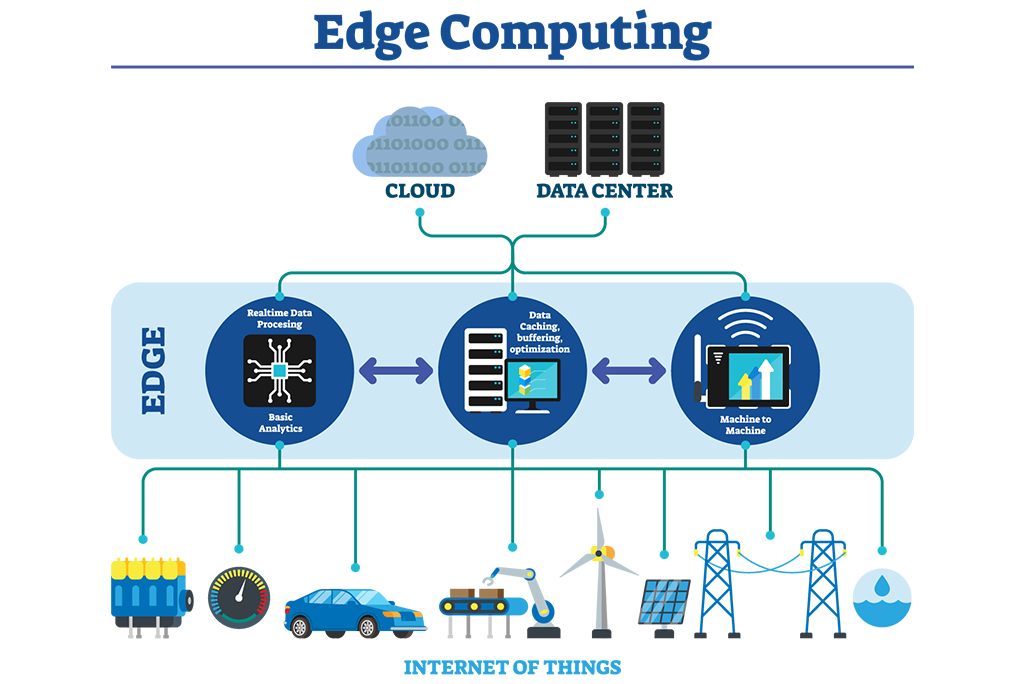“The Heartbeat of Now: Understanding Real-Time Computing
Artikel Terkait The Heartbeat of Now: Understanding Real-Time Computing
- The Rise Of The Digital Assistant: From Science Fiction To Everyday Reality
- Algorithm Development: A Comprehensive Guide
- The Art And Science Of AI Model Training: A Comprehensive Guide
- Federated Learning: Training AI Without Sharing Data
- The Rise Of The Conversational Machines: A Deep Dive Into AI Chatbots
Table of Content
Video tentang The Heartbeat of Now: Understanding Real-Time Computing
The Heartbeat of Now: Understanding Real-Time Computing

In a world increasingly driven by instant gratification and immediate responses, the concept of "real-time" has become paramount. From self-driving cars navigating complex traffic scenarios to high-frequency trading algorithms executing lightning-fast transactions, real-time computing lies at the heart of many critical and innovative technologies. But what exactly is real-time computing, and why is it so crucial in today’s digital landscape?
This article will delve into the intricacies of real-time computing, exploring its definition, characteristics, types, challenges, applications, and future trends. We’ll also address frequently asked questions and provide a comprehensive conclusion to solidify your understanding of this vital computing paradigm.
Defining Real-Time Computing: More Than Just Speed
At its core, real-time computing is a computational paradigm where the correctness of a system depends not only on the logical result of the computation but also on the time at which the result is produced. In simpler terms, a real-time system must guarantee a response within a specified and predictable timeframe. Failure to meet this deadline is considered a system failure, potentially leading to significant consequences.
It’s important to distinguish real-time computing from simply "fast" computing. While speed is undoubtedly a factor, the defining characteristic is determinism. A system can be incredibly fast, but if its response time is unpredictable or varies significantly, it’s not a real-time system. The emphasis is on predictability and guaranteed deadlines, not just raw processing power.
Key Characteristics of Real-Time Systems:
Several key characteristics differentiate real-time systems from traditional, non-real-time systems:
- Determinism: This is the most crucial characteristic. A real-time system must exhibit predictable behavior, ensuring that tasks complete within their designated deadlines.
- Responsiveness: The system must react quickly and efficiently to external events and stimuli. This requires minimal latency and overhead in interrupt handling and task scheduling.
- Reliability: Given the critical nature of many real-time applications, reliability is paramount. The system must be robust and fault-tolerant, minimizing the risk of failure.
- Predictable Resource Management: Resource allocation, such as CPU time, memory, and I/O bandwidth, must be carefully managed and predictable to ensure that critical tasks receive the resources they need on time.
- Time-Constrained Operations: All operations within a real-time system are subject to time constraints. These constraints dictate the maximum allowable execution time for each task.

Types of Real-Time Systems: Hard vs. Soft

Real-time systems are broadly classified into two main categories: hard real-time and soft real-time. The distinction lies in the severity of the consequences of missing a deadline.
Hard Real-Time Systems: In hard real-time systems, missing a deadline is catastrophic and can lead to system failure or even loss of life. These systems are used in critical applications where safety is paramount, such as:
- Flight Control Systems: Ensuring the stability and control of an aircraft.
- Medical Devices: Controlling the delivery of medication or monitoring vital signs.
- Industrial Automation: Controlling robotic arms and other machinery in manufacturing processes.
- Anti-lock Braking Systems (ABS): Preventing skidding and maintaining control during emergency braking.

Hard real-time systems require rigorous testing and verification to guarantee that deadlines are always met. Formal verification techniques and specialized real-time operating systems (RTOS) are often employed to ensure deterministic behavior.
Soft Real-Time Systems: In soft real-time systems, missing a deadline is undesirable but does not lead to catastrophic consequences. The system may experience a degradation in performance or quality of service, but it will continue to function. Examples of soft real-time systems include:
- Multimedia Streaming: Delivering audio and video content with minimal buffering and interruptions.
- Online Gaming: Providing a responsive and lag-free gaming experience.
- Stock Trading Systems: Executing trades quickly to maximize profits.
- Virtual Reality (VR) Systems: Maintaining a smooth and immersive VR experience.
While deadline adherence is still important in soft real-time systems, the requirements are less stringent than in hard real-time systems. Trade-offs between performance and deadline adherence are often made to optimize the overall user experience.
Challenges in Real-Time Computing:
Developing and implementing real-time systems presents several significant challenges:
- Predictability: Achieving predictable behavior is the most fundamental challenge. Factors such as interrupts, cache misses, and context switching can introduce unpredictable delays.
- Resource Management: Efficiently managing and allocating resources to meet deadlines requires sophisticated scheduling algorithms and resource management techniques.
- Complexity: Real-time systems are often complex and intricate, involving multiple interacting components and stringent timing requirements.
- Testing and Verification: Rigorous testing and verification are essential to ensure that deadlines are always met. This can be a time-consuming and expensive process.
- Hardware and Software Selection: Choosing the right hardware and software components is crucial for achieving real-time performance. Real-time operating systems (RTOS) and specialized hardware platforms are often required.
- Concurrency and Synchronization: Managing concurrent tasks and ensuring proper synchronization can be challenging, especially in multi-core systems.
- Power Consumption: Many real-time systems are deployed in embedded devices with limited power budgets. Balancing performance with power efficiency is a critical consideration.
Applications of Real-Time Computing: A Diverse Landscape
Real-time computing plays a vital role in a wide range of applications across various industries:
- Aerospace: Flight control systems, navigation systems, and satellite communication systems.
- Automotive: Anti-lock braking systems (ABS), electronic stability control (ESC), and advanced driver-assistance systems (ADAS).
- Healthcare: Medical devices, patient monitoring systems, and surgical robots.
- Industrial Automation: Robotics, process control systems, and manufacturing automation.
- Telecommunications: Network routing, packet switching, and real-time communication protocols.
- Finance: High-frequency trading systems, risk management systems, and fraud detection systems.
- Defense: Missile guidance systems, radar systems, and electronic warfare systems.
- Consumer Electronics: Smart home devices, gaming consoles, and virtual reality headsets.
Future Trends in Real-Time Computing:
The field of real-time computing is constantly evolving, driven by advancements in hardware and software technologies. Some key future trends include:
- Multi-Core and Many-Core Architectures: Exploiting the parallelism offered by multi-core and many-core processors to improve performance and scalability.
- Real-Time Operating Systems (RTOS) Evolution: Developing more sophisticated and efficient RTOS with advanced scheduling algorithms and resource management capabilities.
- Formal Verification Techniques: Utilizing formal verification techniques to rigorously prove the correctness and safety of real-time systems.
- Artificial Intelligence (AI) Integration: Integrating AI and machine learning techniques into real-time systems to enable adaptive and intelligent behavior.
- Cloud-Based Real-Time Computing: Exploring the potential of cloud computing for real-time applications, leveraging the scalability and flexibility of the cloud.
- Cybersecurity for Real-Time Systems: Addressing the growing cybersecurity threats to real-time systems and developing robust security mechanisms.
- Edge Computing: Bringing real-time processing closer to the data source, reducing latency and improving responsiveness in applications like autonomous vehicles and industrial IoT.
FAQ: Addressing Common Questions
Q: What is the difference between real-time computing and parallel computing?
- A: Parallel computing focuses on speeding up computation by dividing a task into smaller subtasks that can be executed simultaneously. Real-time computing, on the other hand, focuses on ensuring that tasks complete within specific deadlines, regardless of how they are executed. While parallel computing can be used to improve the performance of real-time systems, it is not a defining characteristic of real-time computing.
Q: What is a Real-Time Operating System (RTOS)?
- A: An RTOS is a specialized operating system designed to provide deterministic and predictable behavior for real-time applications. It typically features priority-based scheduling, interrupt handling, and resource management capabilities that are optimized for meeting deadlines.
Q: What are some common scheduling algorithms used in real-time systems?
- A: Common scheduling algorithms include Rate Monotonic Scheduling (RMS), Earliest Deadline First (EDF), and Priority Inheritance Protocol. These algorithms prioritize tasks based on their deadlines, priorities, or other criteria to ensure that critical tasks are executed on time.
Q: How is testing and verification performed in real-time systems?
- A: Testing and verification of real-time systems often involve a combination of simulation, hardware-in-the-loop testing, and formal verification techniques. Simulation allows developers to test the system under various scenarios, while hardware-in-the-loop testing involves connecting the real-time system to a simulated environment to validate its behavior. Formal verification techniques use mathematical methods to prove the correctness and safety of the system.
Q: What programming languages are commonly used for real-time systems?
- A: C and C++ are widely used for real-time systems due to their performance and control over hardware resources. Ada is another language often used in safety-critical applications due to its strong type checking and support for concurrency. Java, with real-time extensions, is also used in some applications.
Conclusion: The Future is Real-Time
Real-time computing is a cornerstone of modern technology, enabling a vast array of applications that demand immediate and predictable responses. From ensuring the safety of flight to facilitating split-second financial transactions, real-time systems are integral to our increasingly connected and automated world.
Understanding the principles, challenges, and future trends of real-time computing is crucial for anyone involved in developing or utilizing these critical systems. As technology continues to advance, the demand for real-time solutions will only grow, solidifying its position as a fundamental aspect of the digital landscape. By embracing the principles of determinism, predictability, and efficient resource management, we can unlock the full potential of real-time computing and create innovative solutions that shape the future.

